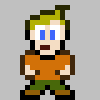Sorry if I am unsure of the proper terms to use, this is all fairly new to me.
I am working on a game, that uses 8bit indexed graphics (for palette shifting/swapping effects).
After about a month of searching tutorials, forums, etc... I am at the point, where I am doing this.....
Each 'character' has a reference to a sprite (object containing a Texture2D) which holds my character image (using the red value of rgb to be an index to the color palette per pixel)
And each 'character' has a local Texture2D for holding that 'character's unique color palette (since different players might color their character's skin, hair, eyes , etc... a different color)
So, each character has to pass its 'image' and 'palette' to the shader.... this is how I am doing it.
Every time I draw a 'character' I call this member function
public void RenderAt(float posx, float posy, DuShader shader)
{
GL.ActiveTexture(TextureUnit.Texture0);
mCurrentFrame.Bind();
shader.SetVariable("texture", (int)0);
GL.ActiveTexture(TextureUnit.Texture1);
mPalette.Bind();
shader.SetVariable("colorTable", (int)1);
GL.ActiveTexture(TextureUnit.Texture0);
shader.Begin();
mCurrentFrame.RenderNoBindAt(posx, posy);
shader.End();
}
My issue with this is that I am having to call shader.Begin, and shader.End per draw. I am no expert at openGL, but it just screams at me as 'bad code'
My original thought , was to have the shader.Begin located at the beginning of the draw loop, then have all my Render calls happen, then at the end call shader.End
This however, did not work, for some reason, I cannot execute the code....
GL.ActiveTexture(TextureUnit.Texture0);
mCurrentFrame.Bind();
shader.SetVariable("texture", (int)0);
from between the shader.Begin and shader.End calls, it only works when the code is executed 'before' the shader.Begin
I have no idea why this is the case. My understanding of shaders and howto use them is from examining about 30+ articles and tutorials over a period of about 4 weeks :P
So... finally my question... what is the 'best' meaning most correct or efficient way to have multiple draw calls to a shader, where the two textures (image and palette) are never the same, and not have to begin and end my shader for each one.
Here is my shader.begin and shader.end code...
public void Begin()
{
GL.UseProgram(mProgram);
}
public void End()
{
GL.UseProgram(0);
}
And the actual GLSL fragment shader...
uniform sampler2D texture;
uniform sampler2D colorTable;
void main()
{
vec2 pos = gl_TexCoord[0].xy;
vec4 color = texture2D(texture, pos);
vec2 palPos = vec2(color.r,0);
vec4 newColor = texture2D(colorTable, palPos);
newColor.a = color.a;
gl_FragColor = newColor;
}
The output i get is correct, meaning it 'works' Ijust need to know if im using it correctly or a better way of doing this.
Thanks in advance, I know its a long winded question, and I tend to ramble :P




